Normally my hobbies get mixed up. I had been playing around with Home Assistant to automate my house. Yes my projects are always on the shoulders of others, and the Home assistant folks make a great open source tool that is mostly easy to use, and runs on a RaspberryPi with a pre-built image. My Hydroponic Garden got two great advances from this, Automation and Monitoring.
Background for independent automation
Reddit is surprisingly great community for hobbyist you can find lots of useful hints there. I found this one about Topgreener Wifi Smart Plugs that were available on Amazon for a great deal. They stopped selling the 4 packs and sell the 2 packs for the same price as 4, so no link. It mentions you can use the tuya convert to update them to ESPHome without having to crack them open and “upgrade” the firmware manually. Another user also provides information on how to get the Energy Monitoring working. The best part is once you upgrade them they no longer require talking to the “mother ship.” Home automation without the cloud or proprietary apps that call home.
Automation upgrades

The Hydroponic Garden got its own dashboard to control the automation of the lights and pumps. This is a much better solution than the old plug timers that would not keep time after a power outage. My neighborhood suffers from poor power reliability, but since all the devices run network time. It gets reset after outage so my lights run consistently.
Monitoring Upgrades
The upgrade of the firmware on the Top Greener TGWF115PQM plugs was super simple after reviewing the Reddit post linked above. This allows me to monitor the power used by my HydroGarden and ensure the Mars-Hydro lights are not getting too old. I’m still running my original burple reflector lights from 2018, so if it ain’t broke no need to fix it. They are still very good lights that use under 250 W and Home Assistant provides great graphs to track the overall Total Daily Energy consumption.




I also get to monitor the Temperature which is why Hydroponics is a winter only hobby for me. I cannot pay to heat up my house with LED lights and then use Air Conditioning to cool it down and remove the excess Humidity. This is provided by a ESP01/8266 and a DHT11 temperature sensor that I got from Amazon of course as the shipping times direct from China are still broken. I would love to not pay the amazon tax and get directly from AliExpress since they have the same vendors.

HydroGardenAutomation_esp01_DHT11 
HydroGardenAutomation_esp8266_DHT11
Well yet another reason I’m a of all trades and master of none. Hobbies require too many disciplines to be the best at any one.




























